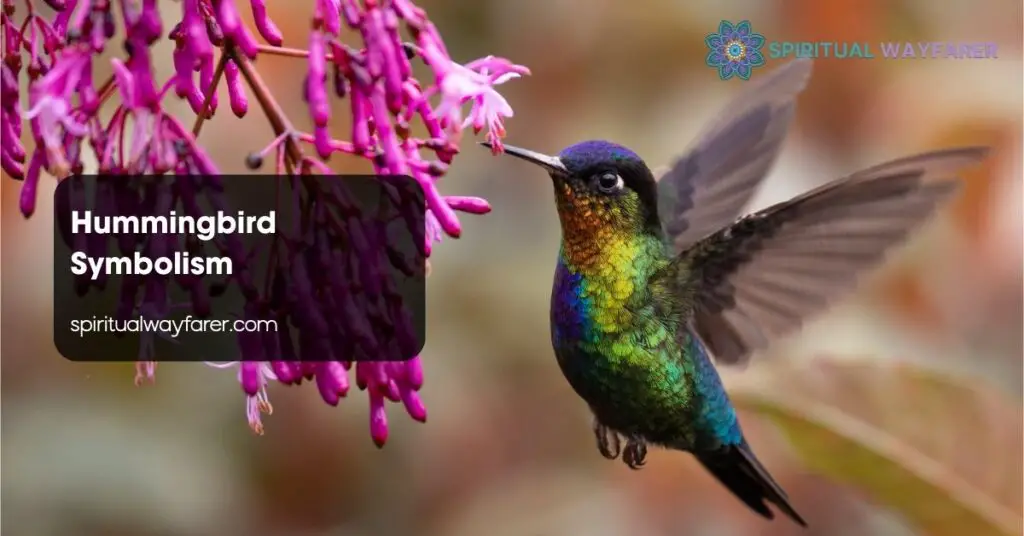Hummingbirds captivate us with their vibrant colors and swift movements, embodying grace and resilience. These tiny marvels flutter through our imaginations, inviting us to explore the deeper meanings behind their presence in various cultures.
As we investigate into hummingbird symbolism, we’ll uncover themes of joy transformation and the pursuit of beauty. Whether you’re seeking inspiration or a deeper connection with nature, understanding these symbols can enrich your life and perspective. Join us on this enchanting journey to discover what hummingbirds truly represent and how their symbolism can inspire us all.
The Meaning Behind Hummingbird Symbolism
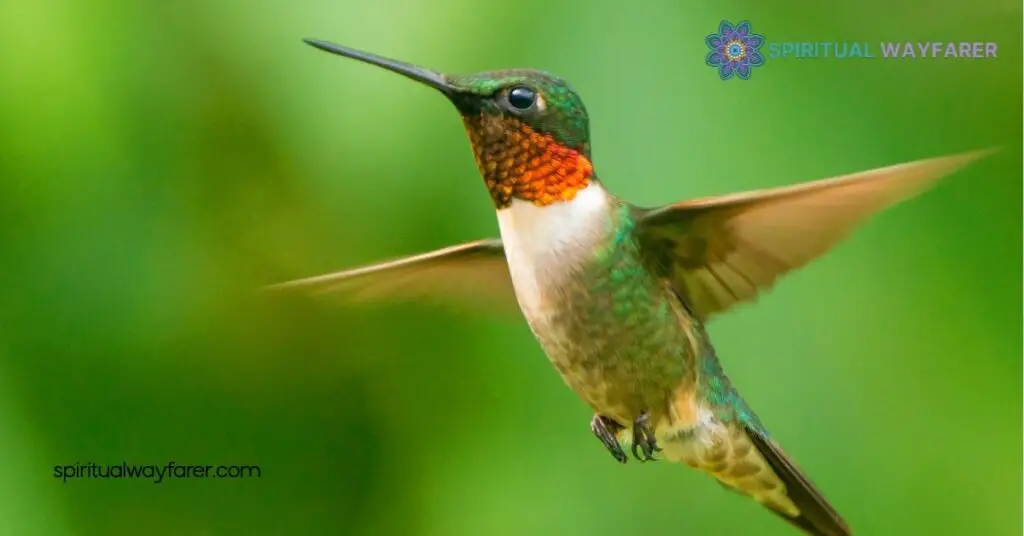
Hummingbirds embody joy and vibrancy, their swift movements reflecting the energy of life. Across various cultures, they symbolize resilience and adaptability, thriving in diverse environments. These tiny birds represent transformation, illustrating the power of change and growth. Also, hummingbirds are seen as messengers of love and beauty, inspiring us to appreciate the finer details in our surroundings. Their presence encourages mindfulness and a deeper connection to nature, reminding us to embrace each moment with grace.
Historical Significance
Hummingbirds have played a pivotal role in the symbolism of various cultures throughout history.
Ancient Civilizations
In Aztec mythology, hummingbirds are intertwined with Huitzilopochtli, the god of the sun, war, and human sacrifice. This deity is depicted as a half-man, half-hummingbird, embodying strength, courage, and agility.[2][3][4]
The Mayans view hummingbirds as powerful symbols connected to the sun, light, and passion. According to their myths, the sun transformed into a hummingbird to chase the moon. Also, hummingbird feathers were believed to possess magical powers, making their killing forbidden by the gods.[1][3][4]
In Inca traditions, hummingbirds are associated with the heavens and regarded as sacred symbols, representing the divine connection between the earth and the celestial area.
Native Cultures
Across various Native American tribes, hummingbirds symbolize joy, beauty, and resilience. For instance, the Navajo see hummingbirds as messengers of good fortune and symbols of positive energy. Similarly, the Hopi tribe regards these birds as representations of love and harmony, often incorporating their imagery into traditional art and ceremonies.
Cultural Interpretations
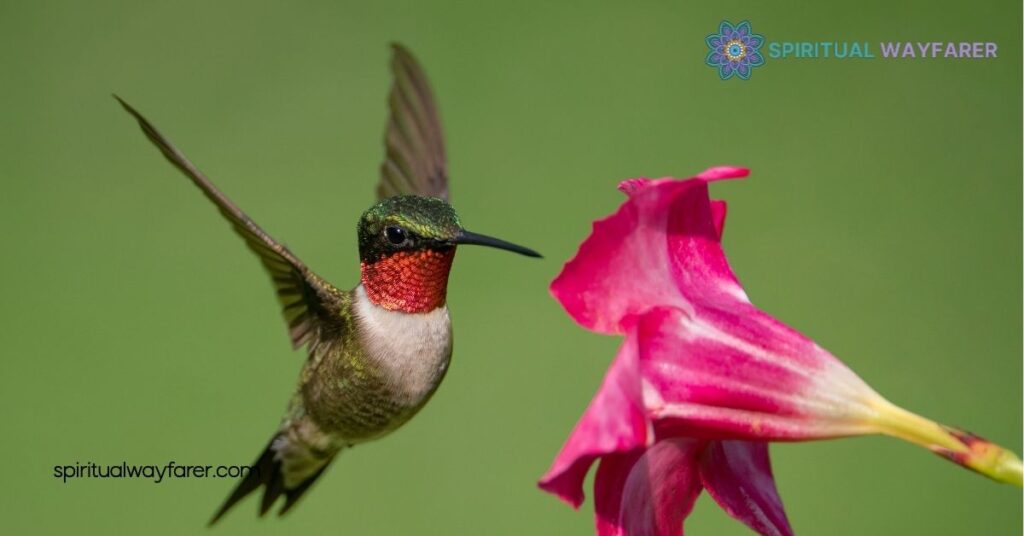
Our exploration of hummingbird symbolism extends beyond Native American cultures, encompassing diverse interpretations worldwide.
Latin American Symbolism
In Latin American traditions, hummingbirds hold important cultural importance. The Aztecs revered them as symbols of love and beauty, often associating them with the goddess of love, Xochiquetzal. Their vibrant colors and agility inspired Aztec art and mythology, representing the soul’s journey and the fleeting nature of life. Mayan culture also esteemed hummingbirds, linking them to the sun and passion. They believed hummingbirds carried messages between the earthly area and the divine, embodying resilience and transformation. These interpretations highlight the hummingbird’s role as a bridge between the physical and spiritual worlds in Latin American societies.
East Asian Symbolism
In East Asian cultures, hummingbirds are appreciated for their grace and vibrant presence. While not as prominently featured as in Latin American traditions, they symbolize beauty and agility in Chinese art and literature. Hummingbirds are often depicted in paintings to represent lightness and the transient beauty of nature. In Japanese culture, their swift movements inspire motifs of perseverance and the delicate balance of life. These symbolic meanings emphasize the hummingbird’s elegance and its embodiment of harmonious existence within the natural industry.
Spiritual and Personal Meanings
Hummingbirds embody profound spiritual and personal significance, symbolizing essential aspects of our inner journeys and emotional well-being.
Transformation and Change
Hummingbirds represent transformation, illustrating the power of change and growth. Their agile movements and ability to adapt swiftly to diverse environments mirror our own capacity for personal evolution. This symbolism encourages us to embrace life’s transitions, fostering resilience and continuous self-improvement.
Joy and Positivity
Embodying joy and vibrancy, hummingbirds infuse positivity into our lives. Their bright colors and energetic flight patterns serve as reminders to seek happiness and maintain an optimistic outlook. In various cultural traditions, hummingbirds are seen as bearers of good fortune, inspiring us to celebrate life’s beauty and embrace moments of joy.
Hummingbirds in Art and Literature
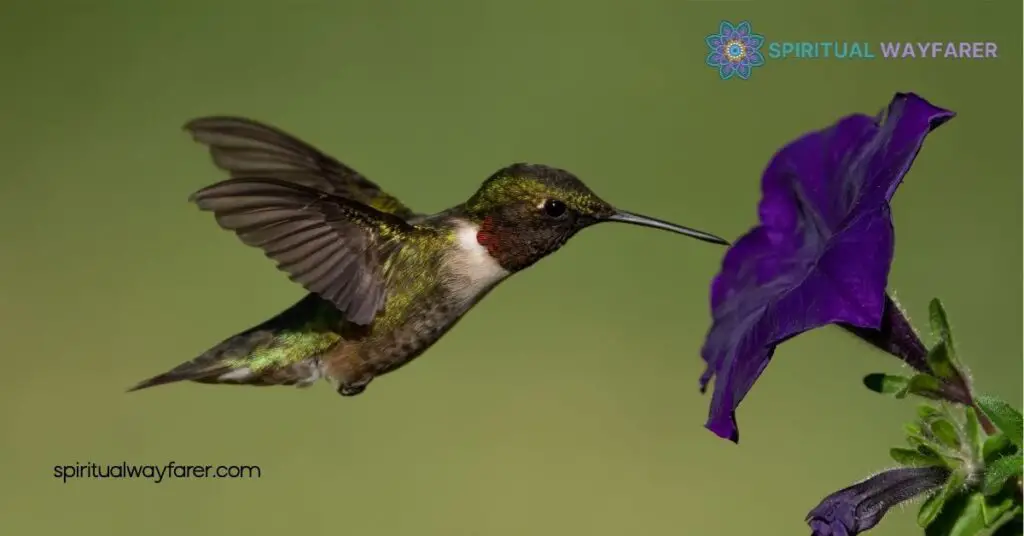
Hummingbirds inspire artists and writers with their vibrant presence and swift movements. Their symbolism enriches various creative expressions.
Representation in Art
Hummingbirds frequently appear in visual arts, embodying several symbolic meanings.
- Vibrancy and Beauty: Artists use bright colors to depict hummingbirds, symbolizing joy and happiness. Their iridescent feathers reflect light, creating mesmerizing color patterns that captivate viewers [1][2][4].
- Cultural Significance: In Native American and South American art, hummingbirds represent hope and spiritual connections. Aztec mythology associates them with Huitzilopochtli, the god of war, symbolizing strength and resilience [4][5].
- Symbolic Imagery: When placed near flowers, hummingbirds in art signify happiness, highlighting life’s small joys.
Symbolism in Literature
Writers incorporate hummingbirds to convey deeper meanings and enhance narratives.
- Themes of Transformation: Hummingbirds symbolize change and growth, reflecting characters’ personal developments or shifts in the storyline.
- Messages of Resilience: Their ability to thrive in diverse environments illustrates perseverance and adaptability within literary contexts.
- Emblems of Love and Beauty: Hummingbirds often represent love and aesthetic beauty, adding emotional depth to literary works.
Modern Symbolic Usage
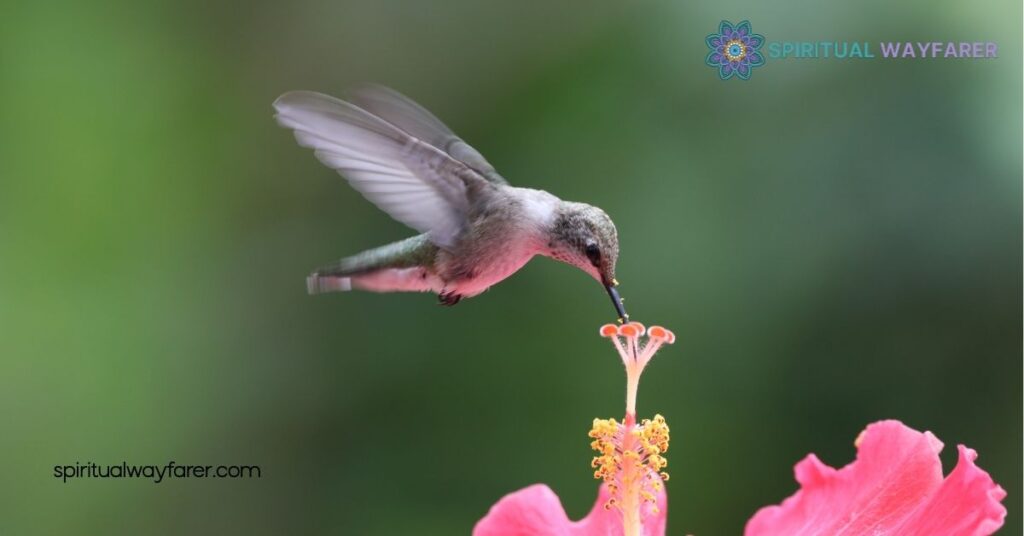
Hummingbirds continue to embody important symbols in today’s society, reflecting their enduring relevance and multifaceted meanings.
Hummingbirds in Contemporary Media
Hummingbirds feature prominently in various forms of media, symbolizing themes like joy and resilience.
- Film and Television: Often represent beauty and transformation, appearing in scenes that highlight nature’s vibrancy.
- Literature: Serve as metaphors for agility and fleeting moments, enriching narratives with their ever-changing presence.
- Art and Design: Inspire visual artists with their iridescent colors, influencing patterns in fashion and graphic design.
- Social Media: Symbolize positivity and mindfulness, frequently used in posts that emphasize appreciation of small joys.
Symbolism in Personal Practices
Individuals incorporate hummingbird symbolism into personal rituals and lifestyles to enhance well-being.
- Meditation and Mindfulness: Represent focus and grace, helping practitioners center their thoughts and embrace the present moment.
- Jewelry and Accessories: Serve as talismans for resilience and beauty, reminding wearers of their inner strength and aesthetic appreciation.
- Home Decor: Introduce elements of nature and color, creating spaces that reflect vibrancy and positivity.
- Life Coaching and Therapy: Use hummingbird imagery to encourage adaptability and the pursuit of personal growth.
Conclusion
Hummingbirds remind us of the beauty and resilience present in nature. Their vibrant presence encourages us to embrace joy and pursue transformation in our own lives. By appreciating these tiny yet powerful symbols we can find inspiration to navigate our personal journeys with grace and positivity. Let the hummingbird’s message of love and adaptability guide us to foster deeper connections and celebrate the fleeting moments that make life truly vibrant.
Frequently Asked Questions
What do hummingbirds symbolize in different cultures?
Hummingbirds symbolize joy, resilience, transformation, and beauty across various cultures. In Aztec mythology, they represent strength and agility, while the Mayans associate them with the sun and passion. Native American tribes view hummingbirds as messengers of good fortune and symbols of beauty. In Latin American traditions, they are linked to love and the goddess Xochiquetzal. East Asian cultures see them as embodiments of beauty and perseverance, highlighting their universal significance as symbols of positive traits and spiritual connections.
How are hummingbirds depicted in art and literature?
In art and literature, hummingbirds are portrayed as symbols of joy, beauty, and transformation. Their vibrant colors and swift movements inspire visual artists to create lively and dynamic pieces. In Native American and South American art, they represent hope and spiritual connections. Literature often uses hummingbirds to convey themes of resilience, love, and personal growth, enriching narratives with their symbolic meanings. Their presence in creative expressions underscores their role as inspirational and enduring symbols across various mediums.
What is the spiritual significance of hummingbirds?
Hummingbirds hold deep spiritual significance, representing transformation, resilience, and joy. They encourage embracing life’s changes and fostering personal growth. As symbols of positivity, hummingbirds remind us to seek happiness and maintain an optimistic outlook. In many cultures, they are seen as messengers of love and good fortune, fostering a deeper connection to nature and our inner selves. Their spiritual presence enhances mindfulness and well-being, making them powerful symbols in personal and spiritual practices.
How do hummingbirds represent resilience and adaptability?
Hummingbirds exemplify resilience and adaptability through their ability to thrive in diverse environments. Their swift movements and agility showcase their capacity to navigate challenges with grace. These tiny birds adjust to various climates and conditions, symbolizing the strength to overcome obstacles and embrace change. In cultural symbolism, hummingbirds inspire individuals to remain flexible and resilient, encouraging them to adapt to life’s transitions and continuously grow despite adversity.
What role do hummingbirds play in Native American traditions?
In Native American traditions, hummingbirds symbolize joy, beauty, and resilience. The Navajo view them as messengers of good fortune, while the Hopi incorporate their imagery into art and ceremonies. Hummingbirds represent hope and spiritual connections, embodying the essence of positive traits and the delicate balance of life. Their presence in Native American culture highlights their importance as symbols of happiness and the enduring spirit, inspiring communities through their vibrant and meaningful representation.
How are hummingbirds viewed in Aztec and Mayan cultures?
In Aztec culture, hummingbirds are linked to Huitzilopochtli, the god of the sun and war, symbolizing strength and agility. The Mayans view them as powerful symbols of the sun and passion, believing the sun transformed into a hummingbird to chase the moon. Their feathers were considered magical and sacred, representing transformation and the soul’s journey. These interpretations reflect the deep reverence Aztec and Mayan civilizations have for hummingbirds as embodiments of divine power and the dynamic forces of nature.
What is the modern significance of hummingbirds in personal practices?
Today, hummingbirds inspire various personal practices aimed at enhancing well-being. They are featured in meditation to symbolize joy and resilience, in jewelry as talismans of good fortune, and in home decor to bring beauty and positive energy. Life coaches use hummingbird symbolism to encourage personal growth and transformation. Their vibrant presence in modern culture continues to inspire mindfulness, creativity, and a deeper connection to nature, making them enduring symbols of positivity and personal development.
How do hummingbirds inspire mindfulness and a connection to nature?
Hummingbirds inspire mindfulness by embodying the beauty of the present moment through their vibrant colors and swift movements. Observing these birds encourages individuals to appreciate the here and now, fostering a deeper connection to nature. Their delicate balance and agility serve as reminders to stay focused and adaptable. Incorporating hummingbird imagery into mindfulness practices enhances awareness and promotes a sense of peace and harmony with the natural world, enriching one’s overall well-being.
Why are hummingbirds considered symbols of love and beauty?
Hummingbirds are seen as symbols of love and beauty due to their vibrant colors and graceful movements. Their ability to hover and dart swiftly reflects the delicate balance and passion often associated with love. In many cultures, hummingbirds are linked to goddesses of love, such as the Aztec Xochiquetzal, emphasizing their role in representing affection and aesthetic appeal. Their enchanting presence in nature and art highlights their timeless association with the pursuit of beauty and the expression of love.
In what ways do hummingbirds represent transformation and growth?
Hummingbirds represent transformation and growth through their incredible adaptability and vibrant energy. Their life cycle and ability to thrive in various environments symbolize personal growth and the power of change. Culturally, hummingbirds are viewed as messengers between earthly and divine realms, illustrating the journey of the soul and continuous evolution. By embodying resilience and the pursuit of beauty, hummingbirds inspire individuals to embrace life’s transitions and strive for self-improvement and transformation.

